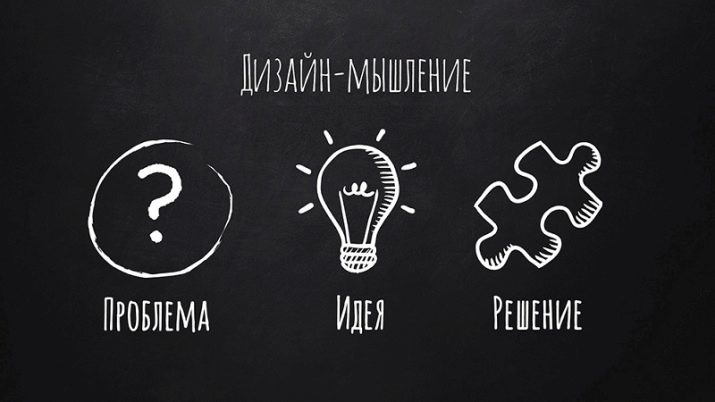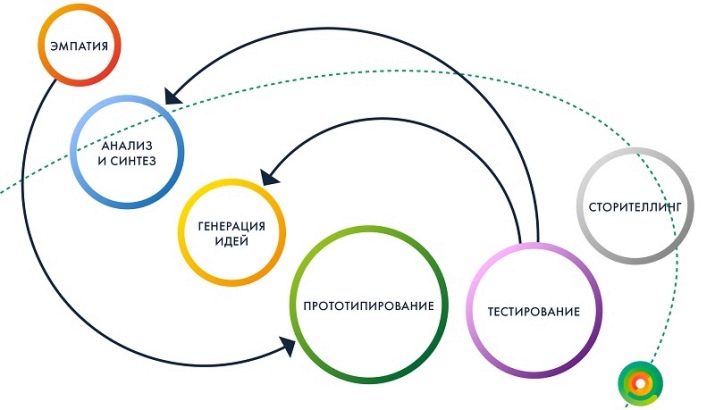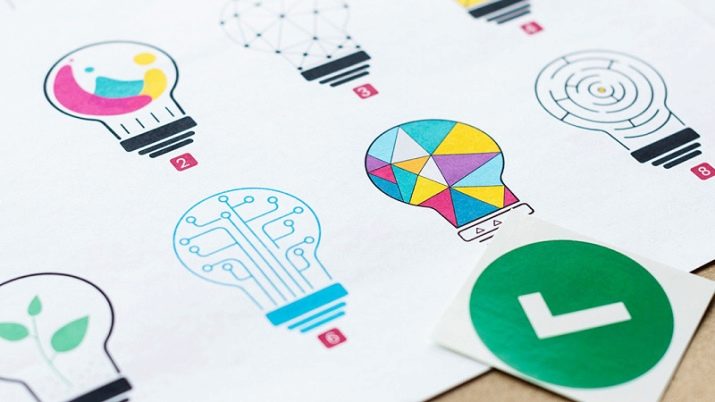Design Thinking: Features, Methods and Development

Not all people can think creatively. In order to have this quality of mind, you must have talent. Creative people tend to have design thinking. Therefore, they are always in trend and in demand at work. If a person has learned to combine talent, creative process and design thinking, then he will turn out to be a good specialist. This employee of the company will be able to create a large number of incredibly beautiful things using simple elements.
In addition, thanks to extraordinary talent, people with design thinking can make the world around them much more comfortable. Do you want to be one of those lucky ones? Then read the following information.

What it is?
So, design thinking is a process that contributes to the search for various extraordinary solutions that can be applied in any area of life. And decisions are based on a creative process. He is an important point here.
Design thinking is closely related to the development of innovative opportunities in the social and business sectors. It helps to find non-standard solutions... For example, to provide a comfortable environment for people with disabilities, a large number of devices have been invented. Such ideas include various turnstiles, special paths. Now they make life much easier for people. Without design solutions, such innovations might not have taken place.
The very idea of introducing design solutions into life arose in 1969. Her inspiration was G. Simon. Later this idea was taken up by scientists. After that, the Design Institute was organized. Since then, many experts have tried to define this phenomenon, and only the Interaction Design Foundation called this process multifaceted.The fund's specialists were able to explain how the problem is being rethought and how the necessary solution is found.
The term "design solution" is based on the principle of anthropocentrism. It involves a variety of studies that serve the interests of the individual. Their the goal is to get out of stereotypes. By and large, design thinking finds its application everywhere. - even where it is difficult to imagine. For example, it is used in the field of home renovation, in the launch of new ideas, in the design of business projects.

However, as with all areas of human thinking, design thinking has its advantages and disadvantages.
The advantages include the following points:
- exact knowledge of the answer to the question of what exactly the buyer wants;
- finding innovative ideas and attracting employees to their implementation.
Among the minuses, the following points should be highlighted:
- at the stage of involvement in the case, employees do not fulfill their direct duties;
- huge resources must be invested;
- the cost may not pay off as search methods may fall short of expectations.
Therefore, you need to try as much as possible combine design thinking and management approach. This will ensure you get the results of the project. and find out what exactly interests the consumer. This direction is able to identify the existing problem. Of course, this approach requires investment, but the investment is quite payback. It's no coincidence that the largest and most modern companies have benefited from design thinking techniques in terms of growth and innovation.
That's why it is necessary to introduce design thinking into business... This approach must be deliberate. If you follow all the rules, then you can solve almost all problems. For example, increase sales or find optimal solutions in personnel management. At the same time, rigid frameworks when implementing a design idea are unacceptable. It should be remembered that this option is a creative approach to solving business problems.
Nevertheless, if the case concerns the documentary registration of the above-described process, then the full order must be observed when it is drawn up.

Principles
Design thinking has such multifunctionality that it can be applied in many areas. All this happens thanks to the following principles.
- Develop for people Is the main goal.
- Show more things that you can touch and see with your own eyes... Be aware that stories and descriptions of the qualities of a subject do not have the desired effect.
- Create a clear outline of the subjectthat you display for the purpose of selling or for any other purpose.
- Approach the project thoroughly... To do this, outline the stages and set the ultimate goal.
- Try all methods, and various experiments will lead to success.
- Listen to different opinionsoffered by experts, and always choose the best of them.
- Move forward and act.
After mastering these principles, you can proceed to the study of the main stages.

Methodology
There is a method for each stage. Consider the methods below for each step.
The techniques for empathy are as follows:
- "Newbie" - this method involves observation;
- "What? How? Why?" - will help to immerse yourself in the topic;
- "Life through the camera" will help you find out all the details of the issue in question;
- "Preparing for an interview" will help prepare for a conversation, for an important meeting;
- "Extreme Users" help you identify fans and those who are not familiar with you;
- "Analogies" help you discover new information;
- "Story Exchange" helps to hear and get to know each other.
Methods for determination include:
- "Filling and grouping" will allow you to find out the needs of users;
- Empathy Map helps to find a method for synthesizing observations;
- "User path" helps to consider every step of the situation;
- "Gathering character" helps to focus on the user;
- "Scale" allows you to do a search for ideas;
- "Matrix 2x2" allows you to organize communication between objects;
- "Ladder" helps to find the middle between the desired and the actual;
- "POV Formula" directs to the detection of a problem at the stage of searching for an answer;
- "POV Analogy" formulates a task in one direction;
- "POV Advertising" targeted at a specific user;
- "Checklist" will help determine the effectiveness;
- "Design Principles" - this is getting a high-quality design solution to the problem;
- method-question "How can we?" - is needed to search for new ideas.

Methods for finding ideas:
- "Warm-up" adjusts to active work;
- "Brainstorm" Is a way to come up with tons of ideas;
- "Facilitating Brainstorming" - preparing the ground for coming up with ideas;
- "Selection" help to select ideas from different directions;
- "Body Storming" designed to find answers to questions, here you need to experience the proposed situation on yourself;
- "Restrictions" help to think about possible obstacles.

Methods for prototyping:
- "A prototype for empathy" gives completely different information;
- "Prototype for testing" helps to validate aspects of your solution;
- "Prototype for a solution" helps to choose the best result;
- "Defining Variables" help you get useful feedback from the user;
- "Prototyping with the user" helps to find a better understanding of the user through observation;
- "Prototype of the Wizard of Oz" - in this case, you need to become a "magician", that is, to give out a functional idea;
- "History method" will help to grab the viewer's attention;
- "Shooting video" - a tool for conveying stories and ideas to the viewer;
- "Mounting" will make your video self-contained.
Testing methods:
- "Testing with the user" help develop the topic;
- "Net" feedback helps to distribute thoughts on key issues;
- "Feedback" in a team improves work efficiency.

Stages
They are made up of basic elements: empathy, focus, idea generation, prototype, test. Let's consider them in more detail.
Empathy
The first stage involves the technology of inclusion in the experiences and experiences of other people. The structure is as follows: you need to define and understand what worries each person. Therefore, this stage is considered the most basic. Here, experts look at the problem through the eyes of people. The designer must look for solutions that satisfy any user.
It is necessary to analyze the market and attract the consumer. This can be done only when you study the demand and its structure, and then start offering your goods or services.

Definition
When information goes through the systematization, then this stage is called "Defining" or "Focusing". This procedure can be done with empathy. Simply put, you need analyze all observations, and then highlight the key points.
The above statement suggests that in any business you need to know in advance what the consumer wants most from your services. Once you know this, you can suggest the product you want.
Searching for an idea
Without this point, progress is impossible. Stage "Generating ideas" (or "seeking an idea") involves setting a problem... And then look for a solution to eliminate it. For example, come up with a large number of ideas and choose the most viable one.
Stereotyping in this matter is unacceptable. Yes, and incorporate your creativity into the idea process. This is the only way you can find the solution you need.

Prototyping
It is necessary to find out the correctness of the idea. Therefore, proceed to the next stage - prototyping. To do this, release a trial version of your idea and test its viability. So you can protect yourself from rash steps and save your money.
For example, you should not invest large sums in an idea you have come up with and release a large batch of goods that you cannot sell. Can to start, create a budget option in a small amount... Then look at the demand, and then draw conclusions.
Testing
To improve the solution to a problem, you need to test all of its points. Typically, this procedure is performed multiple times. It is advisable to pay special attention to prototyping in this matter. You need to act as if you are unsure of success.
Only testing will show the right direction towards the goal. Often, after testing, it turns out that you need to fix everything or start all over again.

How does it work in practice?
Several generations have been discussing this issue since the 1950s. A modern approach to the main strategies of design thinking determines such elements as the innovativeness of the issue, a person's orientation towards connecting intuition, his great responsibility and discipline... The term design thinking includes a wealth of knowledge and experience, which is based on the following points: various market research, critical and imaginative thinking, economics, philology and even philosophy.
Besides, to put forward a concept in the implementation of design thinking, experts use such scientific areas as sociology, anthropology, futurology... For example, in some countries, specialists rely on the above factors and build rather comfortable houses for people. This is how design thinking is embedded in an action-based process. He helps to hear and understand all the desires of city dwellers. So the builders are doing well, and the urban approach works well.
Let's take another example. Often, marketing professionals are faced with the challenge of creating a product out of nothing, that is, creating something that sells by creating an idea. In this case, one cannot do without computer technology. You can create web applications that are accessible to those unfamiliar with the subject of programming. Note that only after the conducted research and various approbations will it be possible to solve this problem. Once the picture begins to clear up, you can combine spreadsheets and visual design. This option will be clear to everyone, without exception. It should be noted here that without special knowledge and design thinking, you would not have succeeded.
In addition, design thinking is also applied in the educational field, since the educational process begins with the question of what knowledge is needed for and where it can be applied. The first reaction to the questions posed will be the answer: "you need to go towards the direction of your needs."
There is only one conclusion here: when a person does not see the goal of learning, he does not strive for it. Therefore, it is necessary to begin the process of uploading knowledge with the advancement of this problem.
The educator must act like a designer, namely to conduct research that will not produce the desired result without asking leading questions. When the whole process is completely completed, then it will be possible to judge the results of the work done. Design thinking needs to be applied in practice in any area, and then a lot will work out.

How to develop?
The process of developing design thinking is all about brainstorming. The more you think and at the same time show creativity, the faster you will launch certain directions in your brain. This type of thinking is necessary for everyone, without exception. The higher the percentage of knowledge, the more you can win life bonuses... The best place to start is by criticizing your decisions. The more you mistrust your decisions, the more you will analyze and think. This means that in the end you will come to the most necessary and intelligent conclusion.It also helps you develop your taste and be competitive in the job market.
Then you need to act according to the following plan.
- Create a folder and put all your ideas in it... After a month, analyze each of them and answer the question which idea you liked the most. This will help you develop your inspiration and move in the right direction.
- Look around more often... Moving along the street, you can come across a lot of interesting things. Analyze what you saw. For example, you can look into a puddle and see just dirt in it. And if you look from the other side, you will notice on its surface the reflection of clouds that confidently float across the sky. Design thinking is creativity. Remember this.
- See how people react to your activity... This way you can realistically assess your knowledge and your work. If there are shortcomings, then it is better to eliminate them in time. Do not be afraid to look at your mistakes with open eyes. With this approach, you will be able to fix them and never commit them again.
- Do more creativity... Only this process makes it possible to quickly develop certain skills. By working with your hands and head, you will quickly achieve what you wanted.
The conclusion here is this: change your thinking, and then it will change you. If you want to improve your knowledge, carefully and systematically complete the necessary tasks.









